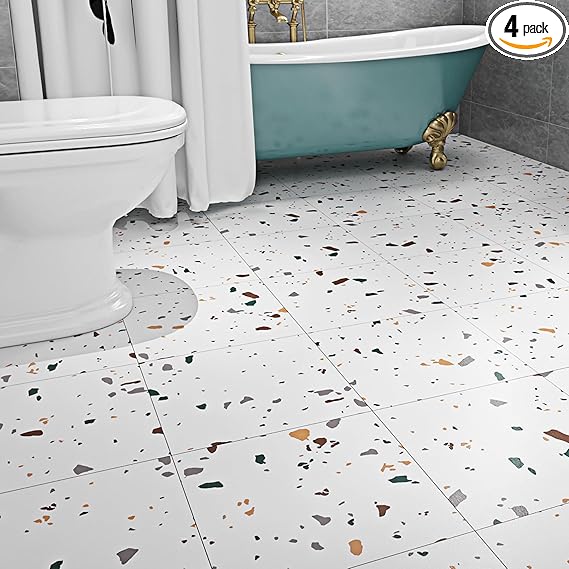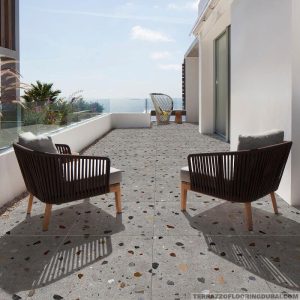When it comes to creating inviting and stylish outdoor spaces, few materials can match the timeless elegance and durability of terrazzo tiles. From patios and decks to garden pathways and poolside areas, outdoor terrazzo tiles offer a versatile solution for enhancing the beauty and functionality of any outdoor environment.
In this blog post, we will explore the beauty of outdoor terrazzo tiles and how they can elevate your outdoor space to new heights. From their stunning aesthetics to their practical benefits, outdoor terrazzo tiles offer a myriad of possibilities for transforming your outdoor living areas into havens of style and sophistication.
Join us as we delve into the world of outdoor terrazzo tiles, uncovering the endless design possibilities, sustainable benefits, and maintenance tips that make them a standout choice for enhancing outdoor living. Discover how outdoor terrazzo tiles can breathe new life into your outdoor space, creating a sanctuary where you can relax, entertain, and enjoy the beauty of the great outdoors.

Brief overview of outdoor terrazzo tiles
Outdoor terrazzo tiles represent a stylish and durable solution for enhancing exterior spaces. Stemming from a rich history, these tiles are a modern adaptation of an ancient flooring technique. Terrazzo itself is a composite material, traditionally composed of marble, quartz, granite, or glass chips mixed with cement and polished to a smooth finish.
In outdoor settings, terrazzo tiles have gained popularity for their aesthetic versatility and resilience. These tiles come in a myriad of colours and patterns, allowing for seamless integration with various design styles. The blend of durability and visual appeal makes outdoor terrazzo an excellent choice for patios, decks, walkways, and other open-air environments.
What sets outdoor terrazzo tiles apart is their ability to withstand the rigours of weather and outdoor conditions. They boast exceptional resistance to fading, cracking, and staining, ensuring a long-lasting and low-maintenance solution for outdoor flooring. As a sustainable option, terrazzo tiles align with eco-friendly design practices, contributing to both style and environmental consciousness in exterior spaces.
Advantages and Disadvantages of outdoor terrazzo tiles
Advantages of Outdoor Terrazzo Tiles:
Durability: Outdoor terrazzo tiles are renowned for their exceptional durability. They can withstand various weather conditions, including rain, sunlight, and temperature fluctuations, making them ideal for exterior applications.
Low Maintenance: These tiles are relatively low-maintenance, requiring simple cleaning to maintain their appearance. Their resistance to stains and wear makes them a practical choice for outdoor spaces.
Aesthetic Versatility: Outdoor terrazzo tiles come in a wide range of colors and patterns, allowing for creative and customised designs. They seamlessly integrate with different architectural styles, from traditional to modern.
Longevity: Terrazzo tiles have a long lifespan, offering a sustainable flooring option. With proper installation and maintenance, they can endure for decades without losing their aesthetic appeal.
Eco-Friendly: Many terrazzo tiles incorporate recycled materials, contributing to sustainable building practices. The longevity of terrazzo also reduces the need for frequent replacements, minimising environmental impact.
Resistance to Fading: Outdoor terrazzo tiles maintain their colour vibrancy over time, resisting fading caused by prolonged exposure to sunlight. This ensures that the flooring remains visually appealing for an extended period.
Disadvantages of Outdoor Terrazzo Tiles:
Installation Complexity: Proper installation of outdoor terrazzo tiles requires skill and expertise. The process involves meticulous attention to detail, and hiring a professional installer is recommended, which can add to the overall cost.
Initial Cost: While the long-term durability of terrazzo makes it a cost-effective choice, the initial installation cost can be higher compared to some other outdoor flooring options.
Weight: Terrazzo tiles can be heavy, requiring a stable and properly prepared substrate. In some cases, additional structural support may be needed, adding to the complexity and cost of installation.
Limited DIY Installation: Due to the complexity of installation, outdoor terrazzo tiles are not well-suited for do-it-yourself projects. This limitation may discourage individuals looking for a more hands-on approach to home improvement.
Potential for Cracking: While terrazzo is generally resistant to cracking, extreme conditions or improper installation may lead to minor cracks over time. Proper care during installation helps mitigate this risk.
Cool Surface in Cold Weather: In colder climates, outdoor terrazzo tiles may feel cool underfoot, which can be a drawback for those seeking a warmer surface in outdoor spaces during chilly weather.

Choosing the Right Outdoor Terrazzo Tiles
Selecting the perfect outdoor terrazzo tiles involves a thoughtful consideration of various factors to ensure they align with your design vision and practical requirements. Here’s a comprehensive guide to help you make an informed choice:
Consider the Location:
- Climate: Choose terrazzo tiles with weather-resistant properties, especially if your outdoor space is exposed to varying climatic conditions.
- Sun Exposure: Opt for tiles that resist fading due to prolonged sunlight exposure, maintaining their aesthetic appeal over time.
Purpose and Traffic:
- Intended Use: Determine the primary function of the outdoor space – whether it’s a patio, pool deck, or garden pathway – to guide your tile selection.
- Traffic Levels: Consider the foot traffic the area will experience and choose tiles with the appropriate durability for the expected use.
Style and Design:
- Colour Palette: Select colours that complement the overall design theme of your outdoor space. Terrazzo tiles offer a broad spectrum of hues to suit various aesthetics.
- Pattern Choices: Explore different patterns – from classic speckled designs to more contemporary geometric options – to find the one that resonates with your style.
Size and Shape:
- Tile Dimensions: Choose the right size of terrazzo tiles based on the scale of your outdoor area. Larger tiles can create a seamless look, while smaller tiles offer more intricate patterns.
- Customization: Explore options for custom shapes and sizes if you have specific design requirements.
Texture and Finish:
- Surface Texture: Consider the desired texture – whether you prefer a polished, honed, or textured finish. The choice can influence both aesthetics and slip resistance.
- Gloss Level: Determine the level of gloss that complements your design. Higher gloss adds a sophisticated sheen, while matte finishes offer a subtler appearance.
Maintenance Requirements:
- Sealing: Check whether the terrazzo tiles require sealing and how frequently. This can impact the maintenance effort needed to keep the tiles looking pristine.
- Cleaning Ease: Consider the ease of cleaning, especially if the outdoor space is prone to dirt, leaves, or other debris.
Budget Considerations
- Cost of Tiles: Understand the cost implications of different terrazzo tile options. Balance your budget with the desired quality and aesthetics.
- Installation Costs: Factor in professional installation costs, ensuring that the overall budget aligns with your financial plan.
Maintenance of Outdoor Terrazzo Tiles
Maintaining outdoor terrazzo tiles is relatively straightforward, but consistent care ensures longevity and appearance. The first step is regular cleaning to remove dust, dirt, leaves, and debris. Sweeping or using a leaf blower helps prevent surface scratches and staining. Occasional washing with mild detergent and water keeps the tiles bright and clean.
Sealing plays a crucial role in maintenance. A high-quality sealer prevents water infiltration, reduces staining, and protects against UV damage. Depending on exposure and usage, resealing may be required every 1-3 years.
Preventive measures can enhance the tiles’ lifespan. Placing mats at entrances, avoiding dragging heavy furniture, and promptly cleaning spills minimize damage. For textured or slip-resistant tiles, gentle scrubbing with a soft brush removes trapped dirt without harming the surface.
Inspecting the tiles periodically is also important. Small cracks, chips, or grout issues should be repaired promptly to prevent further damage. Using appropriate repair compounds ensures seamless restoration without compromising aesthetics.
By combining regular cleaning, sealing, and preventive care, outdoor terrazzo tiles maintain their elegance, durability, and functional benefits for decades, making them a sustainable and visually appealing choice for outdoor spaces.
Design Ideas with Outdoor Terrazzo Tiles
Outdoor terrazzo tiles offer immense creative potential, allowing homeowners and designers to craft unique, stylish spaces. One popular trend is using terrazzo for patio floors, combining neutral tones with colorful aggregates to create a subtle yet elegant base for outdoor furniture.
Pathways and walkways are another ideal application. Terrazzo tiles can be arranged in patterns or mosaics, guiding visitors while adding visual interest. Mixing different colors and sizes can create dynamic effects that enhance garden or landscape aesthetics.
Pool decks benefit from textured or slip-resistant terrazzo finishes, combining safety and style. Light-colored terrazzo also reflects sunlight, keeping the surface cooler underfoot.
Outdoor tables, benches, and countertops can also feature terrazzo surfaces, providing cohesive design continuity while showcasing the material’s durability and ease of maintenance.
Geometric and mosaic patterns are increasingly popular, allowing for customized designs that reflect personal taste or cultural influences. Terrazzo borders, inlays, and medallions can act as focal points in gardens or commercial plazas.
With its wide range of colors, finishes, and design possibilities, terrazzo tiles enable designers to create functional, safe, and visually stunning outdoor environments tailored to any style.
Advantages Over Other Outdoor Flooring Options
Outdoor terrazzo tiles offer distinct advantages over other flooring options like natural stone, concrete, or ceramic tiles. One key benefit is durability. Unlike concrete, terrazzo resists cracking and chipping under heavy foot traffic and harsh weather conditions. Compared to ceramic, it is less prone to breakage from impact.
Aesthetic versatility is unmatched. Terrazzo can mimic marble or granite while allowing customization in color, pattern, and aggregate mix. This makes it easier to match existing design schemes or create unique visual effects.
Low maintenance sets terrazzo apart from stone or wood, which may require sealing, polishing, or staining frequently. Its smooth surface resists mold, mildew, and stains, making it ideal for outdoor conditions.
Slip resistance can be achieved with textured finishes, providing safety around pools or garden paths. Furthermore, terrazzo is eco-friendly when using recycled aggregates, unlike some synthetic outdoor flooring options.
Overall, terrazzo combines durability, aesthetic flexibility, safety, and sustainability, making it a superior choice for outdoor spaces seeking both functionality and style.
Common Mistakes to Avoid
To ensure longevity and aesthetic appeal, homeowners should avoid common mistakes with outdoor terrazzo tiles. One frequent error is improper subfloor preparation, which can lead to uneven surfaces, cracking, or tile displacement. The subfloor must be level, clean, and strong enough to support the tiles.
Neglecting sealing is another mistake. Without a proper sealer, terrazzo can absorb moisture, leading to stains, mold growth, or fading from UV exposure.
Incorrect grout or adhesive selection can compromise durability. Using indoor-grade materials or incompatible adhesives reduces bonding strength, causing tiles to loosen or crack over time.
Ignoring expansion joints is also problematic. Outdoor areas are exposed to temperature fluctuations, and omitting joints can result in stress cracks and damage.
Finally, DIY installation without proper expertise may lead to misalignment, uneven surfaces, or poor finishing. Hiring professionals ensures long-term performance and preserves the tiles’ beauty. Avoiding these mistakes protects your investment and guarantees functional, elegant outdoor terrazzo surfaces.

Installation and Maintenance Tips
Proper installation and regular maintenance are crucial for ensuring the longevity and visual appeal of outdoor terrazzo tiles. Here’s a comprehensive guide to help you navigate the installation process and keep your terrazzo flooring looking its best:
Installation Guidelines:
Professional Installation:
- Terrazzo tile installation requires expertise. Hire a professional installer with experience in handling outdoor terrazzo to ensure precise and durable results.
Substrate Preparation:
- Ensure the substrate is stable, level, and adequately cured before installing terrazzo tiles.
- Address any structural issues or weaknesses in the substrate to prevent future problems.
Quality Adhesive:
- Use a high-quality adhesive suitable for outdoor applications to ensure a strong bond between the tiles and the substrate.
- Follow manufacturer guidelines for adhesive application and drying times.
Proper Grouting:
- Choose a grout suitable for outdoor use, resistant to moisture and temperature fluctuations.
- Grout lines should be uniform and well-sealed to prevent water penetration.
Sealing Process:
- Seal the terrazzo tiles with an appropriate outdoor sealer to enhance stain resistance and protect against the elements.
- Follow the recommended sealing schedule to maintain the effectiveness of the sealer.
Expansion Joints:
- Install expansion joints as per industry standards to accommodate natural movement caused by temperature variations.
Maintenance Tips:
Regular Cleaning:
- Sweep or vacuum the terrazzo surface regularly to remove dirt and debris that can scratch the tiles.
- Mop with a mild, pH-neutral cleanser and water to maintain the tiles’ original shine.
Avoid Harsh Cleaners:
- Refrain from using acidic or abrasive cleaners, as they can damage the terrazzo finish.
- Test any new cleaning products in a small, inconspicuous area before widespread use.
Prompt Stain Removal:
- Immediately clean up spills to prevent staining. Use a soft cloth or sponge with a mild cleanser for most stains.
- Stubborn stains may require a specialised terrazzo cleaner recommended by the manufacturer.
Avoid Sharp Objects:
- Prevent scratches by placing protective pads under furniture legs and avoiding dragging heavy objects across the terrazzo surface.
Regular Sealing Maintenance:
- Periodically check the condition of the sealer and reapply as needed, following the manufacturer’s recommendations.
- Seal high-traffic areas more frequently to ensure continuous protection.
Professional Maintenance:
- Schedule professional maintenance and resealing every few years to enhance the longevity and appearance of the terrazzo tiles.
Repair Chips and Cracks:
- Address any chips or cracks promptly to prevent further damage. Consult a professional for proper repair techniques.
Conclusion
In the realm of outdoor flooring, the enduring allure of terrazzo tiles shines brightly, embodying a perfect synergy of aesthetic elegance and robust functionality. As we conclude our exploration of outdoor terrazzo tiles, it becomes clear that these versatile flooring solutions offer more than just a visually captivating option for exterior spaces—they encapsulate a commitment to enduring craftsmanship and thoughtful design.
The most important frequently asked questions about outdoor terrazzo tiles
Can terrazzo tiles be used outdoors?
Yes, with the right finish and slip-resistant surface.
Are terrazzo tiles waterproof?
Terrazzo is water-resistant but should be sealed to prevent water absorption.
What is the difference between cement and epoxy terrazzo?
Cement terrazzo is traditional and porous; epoxy terrazzo is resin-based, less porous, and more flexible.
How do I clean outdoor terrazzo tiles?
Sweep regularly and mop with mild detergent; avoid acidic cleaners.




